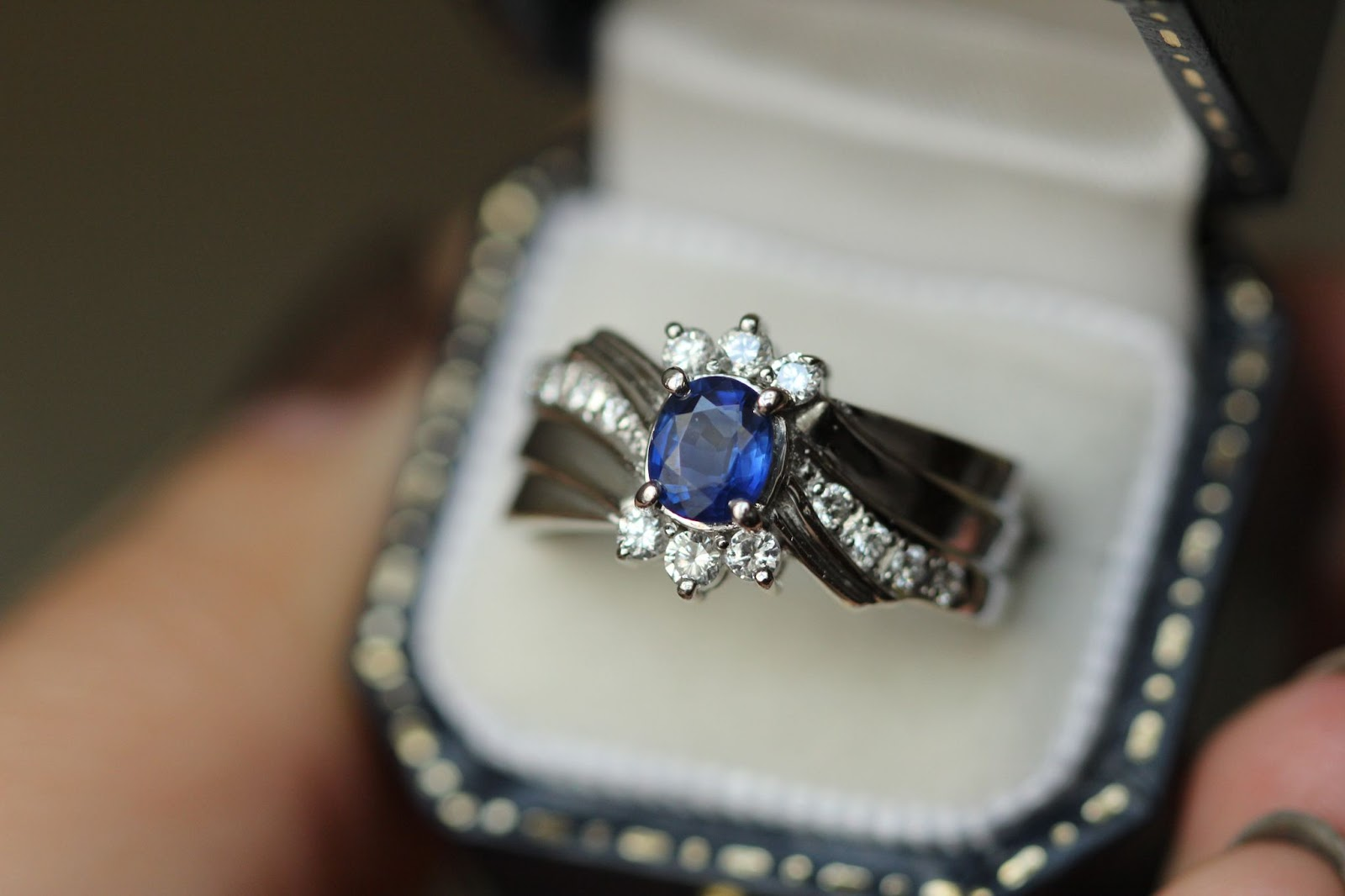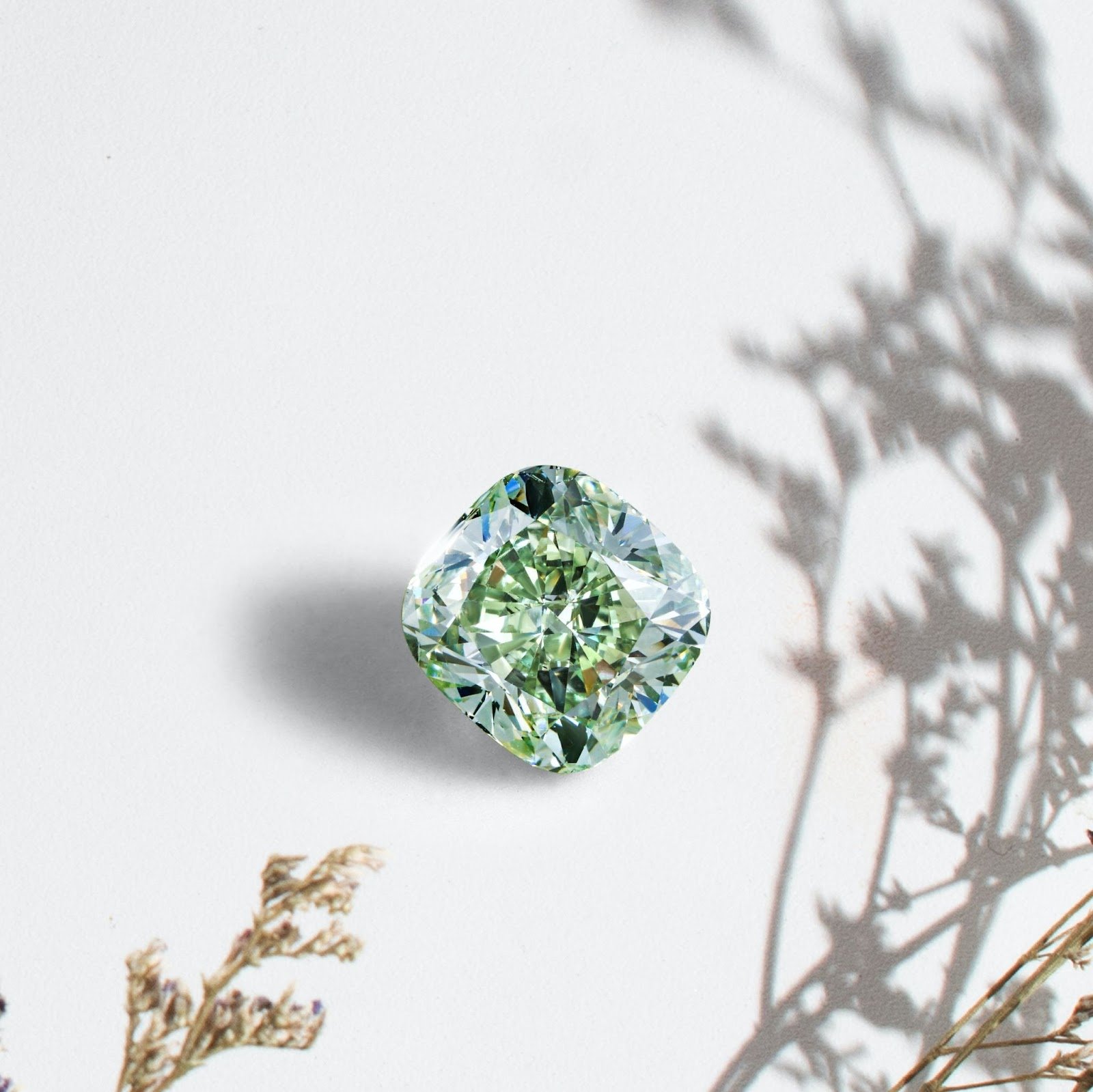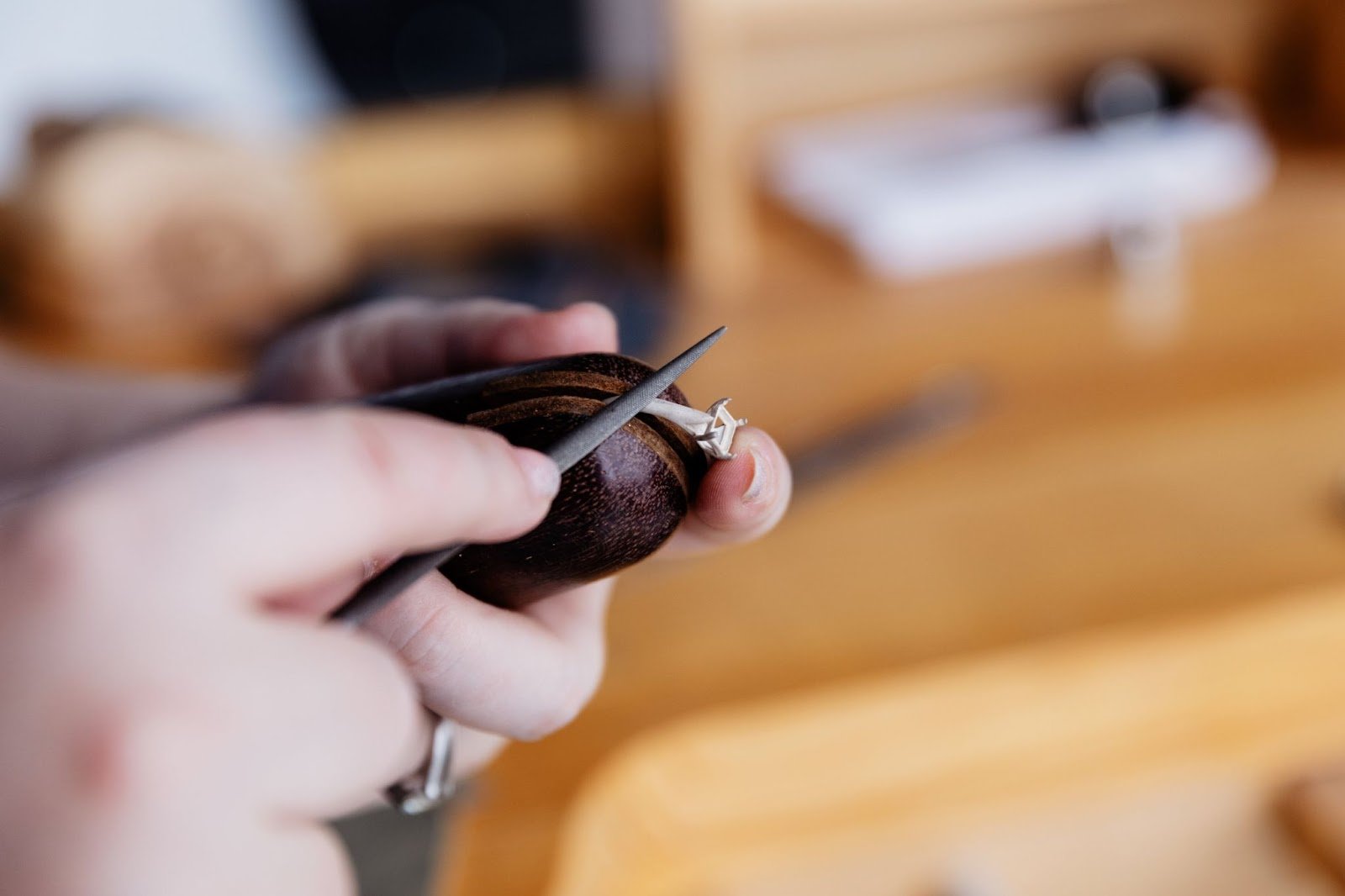What Coloured Diamond is the Most Valuable?
As one of the most well-known types of centre stone for diamond rings, almost everyone is familiar with colourless diamonds, sometimes called white diamonds. While it is widely known that the white diamond is one of the rarest and most beautiful precious stones in the world, few people are familiar with an even more valuable and breathtaking type of diamond that is extremely rare: natural coloured diamonds.
Stunning ring with a beautiful blue diamond as the centre stone
Natural coloured diamonds
As more and more people become aware of the existence of fancy coloured diamonds, they often mistakenly believe that all of them are manipulated or synthetically coloured gemstones. However, fancy coloured diamonds can naturally occur in all colours of the rainbow, from vibrant reds, pinks, and oranges, to bright blues, greens, and purples, as well as gentle yellows, browns, greys, and even blacks.
What are coloured diamonds?
The same as colourless diamonds, natural coloured diamonds are precious and ultra-durable gemstones mined from the earth. Although both colourless and coloured diamonds are composed of the same elements, affected by the same physical processes, and formed over the same timeframe from the same geological regions, there is a small but critical difference between the creation of these two types of diamonds.
This peculiar difference is related to the changes made to the chemical structure of carbon during the formation process, which gives fancy coloured diamonds their beautiful and unique colour. Depending upon the way in which the chemical process of diamond formation was affected, as well as which unusual factors were involved, the result produces extremely rare and exceptionally beautiful natural coloured diamonds.
How are coloured diamonds formed?
Just like colourless diamonds, coloured diamonds are naturally formed out of carbon for millions of years in the earth deep below the surface, at extremely high pressure and a temperature of over 1000 °C. However, during the process of crystallization of coloured diamonds, there are chemical interactions with foreign particles incorporated into the diamond's carbon structure, thus changing the way they reflect light and the colour that our eyes perceive.
Different chemical processes result in different diamond colours. For example, the interactions with other elements such as boron, and nitrogen can create blue or yellow-coloured diamonds. Red or pink diamonds are the result of uncommonly high temperatures or pressures. The formation of green diamonds is due to radiation, and the creation of black diamonds is due to a higher than usual concentration of inclusions of carbon or other native elements.
These tiny changes are extremely rare, occurring in only 0.1% of all diamonds, but can naturally create spectacular colours that are occurring across the entire colour wheel, including red, orange, yellow, green, blue, purples, and every colour in between.
How many colours do diamonds have?
The 27 base colours defined by GIA for fancy-coloured diamonds
According to the Gemological Institute of America, which is considered the ultimate authority in diamonds, coloured diamonds come in 27 base colours. However, with the different levels of intensities and modifying hues, these results can be combined to create over 200 unique colour combinations. The specific colour of the diamond is determined by the base colour and any secondary colours. For example, the colour of a yellow diamond with hints of green would be called a “greenish-yellow.”
The Fancy colour of a diamond also depends on the hue, tone, and saturation of the colour in the diamond. These together are determined by the intensity of the colour in the diamond. The deeper and more intense the colour, the more expensive the diamond will be.
What influences the price of coloured diamonds?
Following the pricing rules of colourless diamonds, coloured diamonds are also graded and priced using the 4Cs: cut, clarity, carat, and colour. However, although the clarity, cut and carat weight still remains an important part of the grading for coloured diamonds and can affect their value, the most important factor that influences the price of coloured diamonds is the colour.
The carat, clarity, and cut of coloured diamonds
The carat represents a diamond’s weight instead of size. Generally, the bigger the carat weight is a diamond, the higher its price per carat will be, and of course, this leads to a higher overall price.
The clarity indicates the diamond’s structural perfection. The impurities inside the diamond are called inclusions, and the small imperfections on its surface are called blemishes. The diamonds with higher clarity have more brilliance and are more likely to be expensive.
A diamond's cut is the way it is polished to best embellish its natural characteristics, maximize its colour, increase its brilliance, and make it appear larger than its actual carat weight. Generally, coloured diamonds are often cut into irregular shapes such as radiant, cushion, pear shapes, which can enhance the intensity of the colour and reflect less white light. Round cut, princess cut, and emerald-cut coloured diamonds are also possible to be found. However, since it is very difficult to cut fancy coloured diamonds into these shapes without losing any of their colours, coloured diamonds in these shapes are usually rare and highly valuable.
Pink, blue and green diamonds from fancy faint to fancy deep (source: GIA)
The colour grading for coloured diamonds
The GIA grades colourless diamonds from D (colourless) to Z (light colour). When the colour of a diamond goes lower than the letter Z on the colour grading scale, it will be graded as a coloured diamond. Coloured diamonds have their own colour grading system, and the way how to determine the value is largely different from that of colourless diamonds. As for colourless diamonds, the less colour there is (closer to grade D), the more valuable the diamond is. With coloured diamonds, it is the opposite: the higher the intensity of the colour, the rarer, and more valuable the diamond is.
Colour can be considered as the most important aspect that influences the value of a coloured diamond, thus the actual price of the diamond. The colour grade of a coloured diamond is determined by its hue, saturation, tone, and distribution. A coloured diamond can have multiple coloured tints, and the most dominant colour is called the diamond's hue.
As the primary colour of the gemstone, the hue can be very intense, which refers to the saturation of the coloured diamond. If the saturation of a coloured diamond is very intense, the value is much more than a light saturation. In addition, the tone of the coloured diamond represents how light or dark the colour in the diamond appears and the distribution refers to how evenly the colour is spread inside the whole diamond.
Thus, the hue, tone, saturation, and distribution are the major players that determine the price of a coloured diamond and together consist of the elements to be examined during the colour grading of a coloured diamond. According to these factors, from the lightest to the deepest, GIA graded the colour of coloured diamonds from faint, very light, light, fancy light, fancy, fancy intense, fancy vivid, fancy dark, to fancy deep.
Rarity
When talking about pricing, the basic rules of the economy always apply. This means that supply and demand also control the prices of fancy coloured diamonds. In this case, the supply is basically determined by the rarity of the colour of the diamond, and how hard it is to obtain it.
Naturally coloured diamonds are rare because it is very difficult to find them in nature. In the diamond industry, the majority of the diamonds mined from the earth are colourless. Normally, for every 10,000 carats of diamond mined, only one will be a true coloured diamond. In addition, coloured diamonds are usually found below 1 carat. This makes coloured diamonds above 1 carat extremely expensive.
As yellow colours are often to be found in colourless diamonds, yellow and brown diamonds make up the majority of coloured diamonds. And naturally coloured diamonds usually have faint colours, it is even rarer to find a naturally occurring coloured diamond with medium to dark tones, which is what often drives prices higher for coloured diamonds with deeper colour intensity!
Fashion trends
When it comes to demand, it is humanity that decides the trend. People are always wanting what they can't have and what others don't have, and can easily be influenced by others’ opinions. That’s why they are demanding rarer coloured and extraordinary coloured diamonds, following the fashion trends lead by celebrities. These fashion trends usually represent a huge increase in the price of certain coloured diamonds in a short period of time.
Gorgeous ring with extremely rare large-carat fancy-vivid pink diamond
Most expensive coloured diamonds
As fancy coloured diamonds become increasingly popular with investors and people who seek to use them in jewellery, the question regarding which colour diamonds are the most expensive is a perfectly legitimate one to ask. Unfortunately, the answer is not clear, and it has actually changed over time.
As there are numerous numbers of diamond colours, to better answer this question, we can divide the fancy coloured diamonds into several main categories according to their pricing: affordable coloured diamonds, mid-price range coloured diamonds, super rare and expensive coloured diamonds, and the most expensive coloured diamonds.
Affordable coloured diamonds
The least expensive and relatively affordable diamond colours include grey, brown, and fancy yellow, which are the colours that are most frequently found among coloured diamonds. While these coloured diamonds are rarer than ordinary colourless diamonds, due to their generally lower level of demand, they are usually less expensive than colourless diamonds of equivalent quality and carat weight. However, the relatively lower cost does not apply to diamonds with higher intensities, like vivid or fancy vivid yellow, or diamonds with more valuable modified colours, such as purplish-grey diamonds.
Mid-price range coloured diamonds
The mid-range priced coloured diamonds mainly include intense and vivid yellow diamonds and orange diamonds. The pricing level for this group of coloured diamonds may vary dramatically depending on the intensity of the colour, the existence of a secondary hue or the strength and tone of the secondary colour. Generally, the colour diamonds in this price range are slightly more expensive than colourless diamonds.
However, as the range of prices for this group of diamonds is extremely huge, they also include certain coloured diamonds that are cheaper than colourless diamonds and diamond colours nearly as valuable as super rare diamonds. For example, pure orange diamonds cost an extremely high price and nearly reach the high pricing range, while coloured diamonds with a secondary brown or yellow tint such as brownish or yellowish-orange diamonds almost cost the same price as equivalent white diamonds.
Super rare and expensive coloured diamonds
The coloured diamonds in this price range include pink, purple, green, blue, and violet diamonds, and are significantly more expensive than colourless diamonds. The diamonds naturally grown in these colours are very rare, with a price per carat typically starting from tens of thousands of dollars. And the higher the carat weight and colour intensity, the value will increase exponentially.
Loose diamonds of these rare colours are usually sold through auctions for bids that can easily reach millions of dollars.
The most expensive coloured diamonds
Red diamonds are the rarest and of course the most expensive of the coloured diamonds, which will cost over $1 million per carat on average. They are so rare that only 20 or 30 truly red diamonds have ever been discovered in the entire world. Red diamonds usually exist only from 0.5 carats to 1 carat in size and come only in fancy intensity.
Pure red diamonds are too rare, and typically red diamonds often have a purple tint in them. In general, a 0.20-carat purplish red diamond will cost about $300,000 per carat, and the price is about $500,000 for a 0.40-carat purplish red diamond.
Even if the red colour is present in the diamond at a very low saturation as a secondary tone, the price of the diamond can rise exponentially. As a result, while a brown diamond costs only about $2,400 per carat, a reddish-brown diamond can cost a striking $30,000 or more per carat, which is more than 12 times the price due to the red colour! No other colour diamond has such a dramatic effect when it appears as a secondary tint.
Weighing 5.11 carats, the most famous red diamond is called Mousaieff Red, which is the largest red diamond ever found. It was sold at $1.6 million per carat, which has a total price of $8 million. Another 1.56-carat red diamond, Argyle Phoenix, was sold for more than $1.25 million per carat.
Fancy-coloured lab-grown diamonds: a cost-efficient substitute for natural coloured diamonds
The same as natural mined diamonds, lab-grown diamonds are also made of pure carbon and are formed in the same way as mined diamonds. The identical chemical foundations give lab-grown diamonds the same physical, chemical, and optical properties as natural diamonds, as well as the same scintillation, brilliance, and shimmer. Lab-grown diamonds are as real as natural mined diamonds. With the differences invisible to naked eyes, It is very difficult to identify lab-created diamonds and earth-mined diamonds, they can only be differentiated by professional geologists using specialized equipment.
Cushion cut high quality fancy green lab-grown diamond。
Formed over millions of years within the earth’s crust, natural diamonds happen to get their original characteristics under extreme conditions, and how fancy-coloured diamonds get their unique colours are more like a miracle of mother nature. That’s why all the natural mined diamonds are born with forever rarities, which is one of the most important factors that cause the extremely expensive price of fancy-coloured diamonds.
However, on the other hand, there’s no intrinsic rarity for lab-grown diamonds as they are grown to a uniform standard, and can be produced without limit. Also, unlike the determination of the fancy-coloured natural diamonds price which is based on each diamond’s unique characteristics and rarity, the pricing of lab-grown diamonds can only depend on the diamond’s carat weight. What’s more, With the benefit of unlimited production capacity, lab-grown diamonds are priced significantly lower than natural mined diamonds, and the price difference can be even more intensive for fancy-coloured diamonds with high-intensity rare colours.
Specialized in lab-grown diamonds, EverDear™ offers high-quality GIA-certified lab-created diamonds in a wide array of vivid colours from yellow, orange, green, and blue to rare colours such as black, pink, and even red. The cutting-edge technology of EverDear™ results in lab-grown diamonds created with rich and high-intensity colours that are extremely rare and expensive in natural mined diamonds, but much more affordable.
Take a close look at the price difference between EverDear™ lab-grown diamonds and fancy coloured natural diamonds, it is clear that choosing a lab-created coloured diamond is a better option. As an example, a 1-carat earth-mined fancy deep pink diamond may cost you about $300,000, while the EverDear™ lab-grown counterpart with almost the same characteristics can save you about 90% of the cost! What’s more, as natural red diamonds are extremely rare and mostly auctioned at an incredibly high price per carat, you can get bigger, brighter lab-grown red diamonds with better colour intensity at EverDear™ for only a fraction of the price of its earth-mined counterpart.
Lab-grown fancy coloured diamonds are identical in every way to the diamonds you can get from the earth and priced phenomenally less, see tens to hundreds of thousands than a comparable natural colour diamond! Whether you are looking for a Fancy Vivid Yellow diamond or special diamonds with Stunning Red hues, EverDear™ has got conflict-free and eco-friendly lab-created diamonds with gorgeous and even customizable shapes and colours to suit your unique style.



































